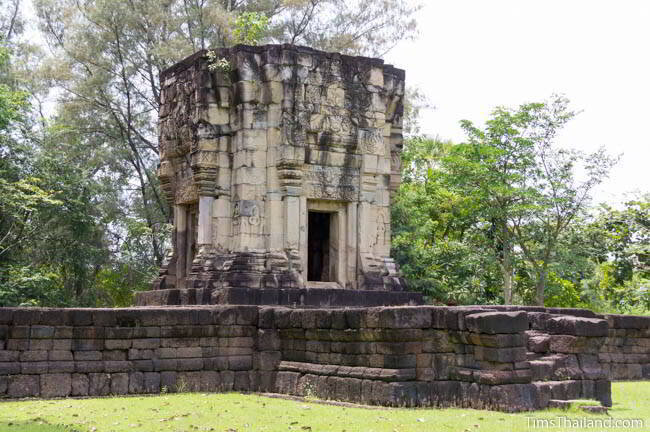Avalokitesvara, Lokeshvara
sk अवलोकितेश्वर Avalokiteśvara (" lord who looks down and watches [the world]") | लोकेश्वरः Lokeśvara ("Lord of the World") | also पद्मापाणी Padmapāni ("Holder of the Lotus")
kh លោកេស្វរៈ Lokesvara [Sealang Dictionary] | អវលោកិតេស្វរៈ Avaloketesvara "who anticipates as great", លោកេស្វរៈ Loksvara [Chhuon Nath Dictionary]
ch 觀音 Guanyin /Kuan Yin (female deity) | tl நாதா Nātha | vn Quan Am (female deity) | tb སྤྱན་རས་གཟིགས Chenrezig ("eye looks with continuity", male and female) | bh Avalokitesvara
Lokeśvara ("Lord of the World") and Chenrezig (in Tibetan) is a tenth-level bodhisattva associated with great compassion (mahakaruṇā), and often with Amitabha Buddha in Mahayana Buddhism. Avalokiteśvara has numerous manifestations and is depicted in various forms and styles. In some texts, he is even considered to be the source of all Hindu deities (such as Vishnu, Shiva, Saraswati, Brahma, etc).
In modern Cambodia, the four faces of Avalokitesvara (or Avaloksvara, Loksvara) are usually represented at the top of a pagoda or a stupa, as protector of all the planets. When Brahmanism was popular, these faces were considered as the faces of Brahma. In ancient Khmer art, he is represented with two, four, six or eight arms in freestanding sculptures, and ten arms in temple bas-reliefs such those at Banteay Chhmar. The massive stone faces of Bayon are believed to represent Lokeshvara.
Khmer worship of Lokeshvara reached a peak during the reign of Jayavarman VII. Due to his healing powers, the he was given a predominant position in the scenes carved on the chapels of the hospitals built by this king. Lokeshvara was also omnipresent at Neak Poan Temple, whose waters could cleanse the sins and diseases of the pilgrims. Jayavarman VII dedicated the temple of Preah Khan Temple to the memory of his father, deified in the likeness of Lokeshvara.
A sculpture from Prei Monti (Roluos), late 12th-early 13th century, at the National Museum of Cambodia (piece Ga.2424), represents three adorned divinities: Buddha shelled by the Naga in the middle, Lokesvara to the right of the Buddha, and Prajnaparamita to the left. Lokesvara's attributes are the lotus bud, rosary, vase with water of immortality (amrta) and book. Those of Prajnaparamita include the book and the lotus bud.
While Avalokiteśvara was depicted as male in India, and male or female in Tibetan tradition, the deity is often depicted as a female figure in East Asian Buddhism, known as Guanyin /Kuan Yin in Chinese, Kannon in Japanese, Gwaneum in Korean and Quan Am in Vietnamese. In Sri Lanka, Natha literally means ‘no form’ or ‘no shape’, thus associating Avalokiteśvara with Maitreya, the next Buddha
Avalokiteśvara is also known for his popular mantra, oṃ maṇi padme hūṃ, which is the most popular mantra in Tibetan Buddhism.

